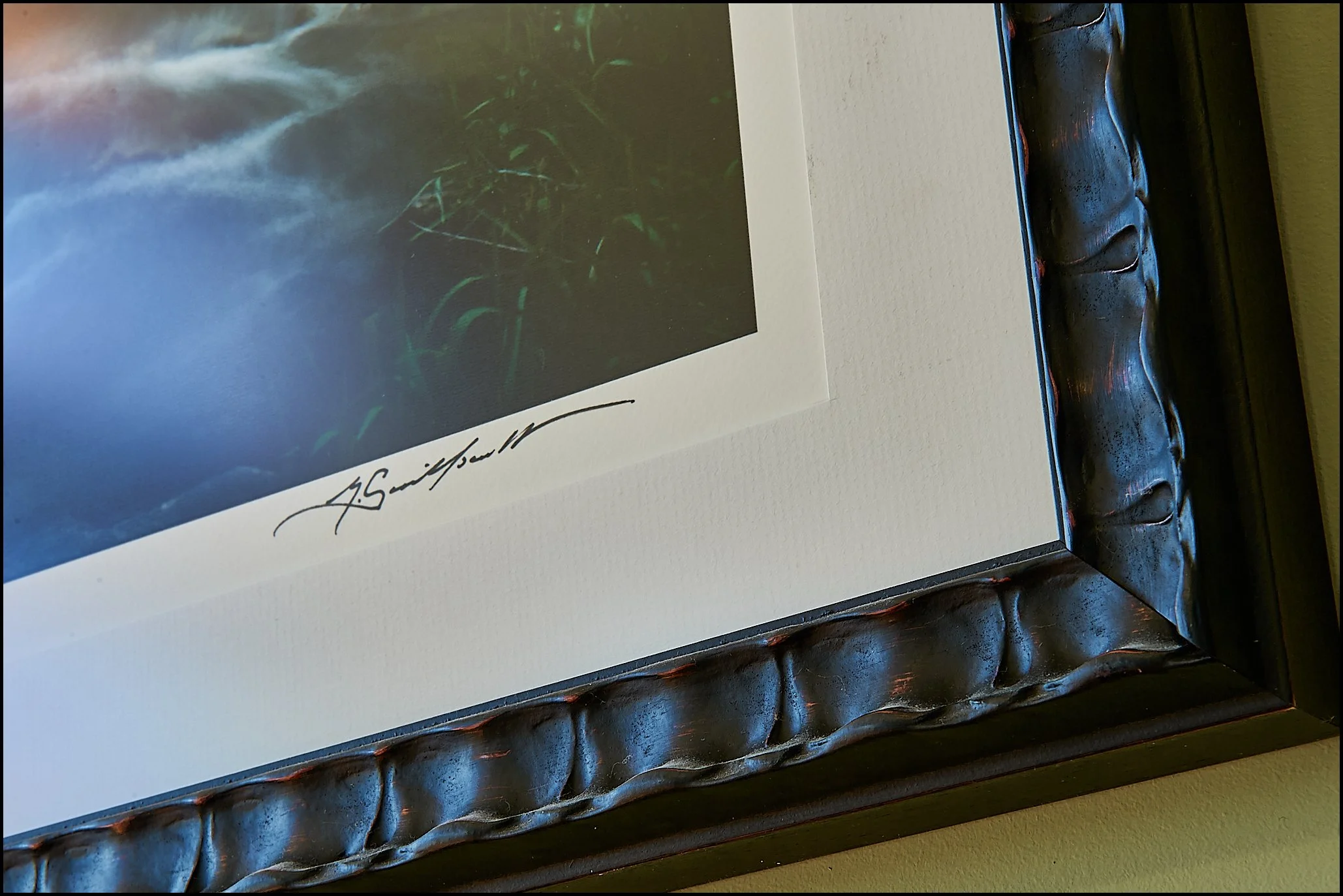THE FINE ART PRINT
New 'state-of-the-art' printing technology enables us to produce prints to standards previously only available by fine art print shops. The array of inks and papers available to us today allows us to create prints of unprecedented longevity - much greater than traditional photographic print techniques.
GICLÉE PRINTING
You'll hear the term Giclée printing used interchangeably with ink-jet printing. It’s a term coined to describe the method of laying down ink on paper to create a photograph. I believe the literal French translation is 'to spurt', which of course is what ink-jet printers to - spurt, or squirt out ink. Whatever you call it, the quality that's available now if far superior to anything we've been able to produce in the past.
THE INK
At the core of this new technology is the ink set used in large format professional printers. They include inks that are made with pigments rather than dyes. The advantage of pigment ink is that it's very stable and less prone to fading than the typical dye-based inks found in consumer quality ink-jet printers. A whole new technology of printer equipment needed to develop to take advantage of these inks. Not only are the colours richer and brighter than ever before, the new set includes varying shades of black to create incredibly rich detail in Black & White photography.
THE MEDIA
Ink is no good without some sort of medium to print on. Paper has been around for thousands of years, but the selection available for Fine Art Printing, especially of photography, has never been better.
Our Signature Papers
We have a carefully curated, defined selection of high-quality papers available for print sizes up to 16x20”. Among these, our finest heirloom options include the Signature Worthy Fine Art paper and the Legacy Fine Art paper, both meticulously hand-made in Europe, a region renowned for producing some of the finest papers in the world.
These papers are crafted from 100% cotton, featuring a heavyweight feel and offering either a smooth or textured surface option, all designed to meet strict archival standards. They are completely acid-free and lignin-free and contain no Optical Brightening Agents (OBA’s), which are known to cause prints to discolour over time. The naturally white tone of the paper enhances the viewer’s connection with the image far beyond the typical ‘lustre’ finish found on standard photographic papers familiar to most consumers.
These high-quality prints are produced entirely by us using our Epson Stylus Pro pigment ink printer, ensuring exceptional color accuracy and detail in every piece. The fine art papers satisfy the highest industry standards concerning density, colour gamut, colour radiation, and image sharpness, all while maintaining the authentic tactile experience and special feel of genuine art paper
Sizes larger than 16x20 are also available on Fine Art papers, printed at our partner lab in Toronto. We use the same or similar quality fine art papers as mentioned before.
Fine Art Portrait
Master's Gallery Canvas
Our canvas of choice was selected for it’s ability to maintain the depth of colours and tonal quality associated with our Fine Art Heirloom papers. The canvas is stretched over a hardwood frame to improve stability over various environments.
A NOTE ABOUT CANVAS
Photographic canvas is a natural fibre material, typically cotton based, and therefore is subject to environmental conditions such as temperature and humidity. You may fined that the canvas will expand a little in the hot and humid summer months, but will typically contract over the winter months. This is normal and should not affect the image or wooden stretcher.
What is Fine Art Photography?
The word “Fine” in Fine Art, comes from the French word for finished; “fini”. Meaning that the work is complete in itself without further purpose, like commercial photography, other than to be viewed.
As AI describes it;
Fine art photography is photographic artwork created as an expression of the artist's personal vision, idea, message, or emotion, rather than for documentary or commercial purposes. It prioritizes the artist's conceptual idea and unique perspective, using photography as the artistic medium to convey a subjective intent, and distinguishes itself from photojournalism and commercial photography.
Key characteristics
Artist's Vision:
The primary goal is to communicate a message, concept, or emotion unique to the photographer.
Subjectivity:
The work conveys the artist's feelings and how a scene impacted them, rather than an objective, literal representation of reality.
Creative Expression:
Photography serves as the chosen artistic medium for the photographer to express their ideas and creativity.
Aesthetic and Imaginative Qualities:
Fine art photographs are created for their aesthetic appeal and imaginative content.
Distinctions from other photography types
Unlike fine art photography, commercial photography focuses on advertising products or services.
Photojournalism aims to provide a factual, documentary visual account of specific events, whereas fine art photography is subjective and expressive.
Snapshot Photography:
Images taken without any particular artistic vision or purpose are distinct from fine art photographs, which are carefully curated and intentional.
Examples of subject matter
Fine art photography can encompass a wide variety of subjects, including: Landscapes, Portraits, Still lifes, and Abstract images.


